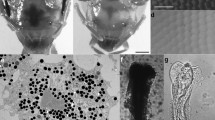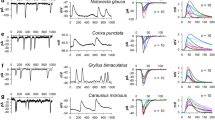Summary
It has been recorded intracellularly from single visual cells in the compound eye of the blowflyCalliphora erythrocephala, mutant “chalky”.
-
1.
The stimulus-response curves (V-log I curves) obtained by short test flashes are sigmoid curves with an almost linear part of 4.5 log units (Fig. 4).
-
2.
V-log I curves obtained by a long-lasting stimulus of 30 sec exhibit a distinct maximum (Figs. 6 and 7).
-
3.
The “increment sensitivity”E i is defined as the reciprocal of that additional intensity that causes equal stimulus responses with different adaptation intensities. LogE i versus log adapting light shows a characteristic deviation from the “Weber-Fechner law” (slope = 1) (Fig. 9) with a slope of − 0.67 in the lower and − 2.0 in the higher adaptation range.
-
4.
The sensitivityE 0 is defined as the reciprocal of that total intensity (adaptation plus test light intensity) that causes equal potential height (response to test light plus response to adaptation light).E 0 also does not obey the “Weber-Fechner law” over an adaptation range of 6 log units. Here the mean slope is − 1.33 (Fig. 11).
-
5.
In a theoretical section an attempt is made to correlateV-log I functions produced by short test flashes to concentrations of certain coloured intermediate pigments in the reaction chain of pigment bleaching (Fig. 14). There is no simple functional relation to be found.
-
6.
There was good evidence that the maximum functions obtained with long-lasting stimuli were functionally associated with the accumulation of certain coloured intermediates throughout the duration of the stimulus (Figs. 6, 7, 16).
-
7.
The “increment sensitivity”E i of a single visual receptor of the blowfly was compared with the subjective threshold sensitivity of a rod monochromat. An exact agreement was found over an adaptation range of 6 log units provided that in human threshold measurements small light spots were used. Similar experiments done on single receptors of the honeybee drone also showed good agreement (Fig. 17).
-
8.
From these results it is concluded that the “Weber-Fechner law” is applicable only to reactions of the whole retina (including at least peripheral nervous interaction) such as the ERG whereas the characteristic sensitivity function of single receptors has no constant exponent. The deviations from the “Weber-Fechner law” were identical for the single receptors of the fly, the honey-bee drone, and man.
Zusammenfassung
Es wurde intrazellulär von einzelnen Photorezeptoren im Komplexauge vonCalliphora erythrocephala, Mutante „chalky”, abgeleitet.
-
1.
Die Intensitätskennlinien bei kurzen Testblitzen folgen einer S-förmigen Kurve (halblogarithmische Auftragung) mit einem annähernd linearen Bereich von 4,5 Zehnerpotenzen (Abb. 4).
-
2.
Die Intensitätskennlinien bei Dauerreizen von 30 sec zeigen ein deutliches Maximum bei mittleren Intensitäten (Abb. 6 und 7).
-
3.
Die UnterschiedsempfindlichkeitE i ist definiert als der Kehrwert derjenigen Testlichtintensität, die bei verschiedenen Adaptationsintensitäten konstante Antworthöhen hervorruft. LogE i aufgetragen gegen log Adaptationslichtintensität weicht mit einer mittleren Steigung von −0,67 bei niedrigeren und −2,0 bei höheren Adaptationslichtintensitäten in charakteristischer Weise von der „Weber-Fechner-Regel” (Steigung: 1) ab (Abb. 9).
-
4.
Die EmpfindlichkeitE 0 wird definiert als der Kehrwert derjenigen Gesamtlichtintensität (Test- plus Adaptationslichtintensität), die bei verschiedenen Adaptationsintensitäten gleiche Gesamtpotentialhöhen (Antwort auf den Testreiz plus Antwort auf den Adaptationsreiz) hervorruft. AuchE 0 gehorcht nicht der Weber-Fechner-Regel mit einer mittleren Steigung von −1,33 in dem untersuchten Adaptationsbereich von 6 Zehnerpotenzen (Abb. 11).
-
5.
In einer theoretischen Erörterung wird versucht, den Verlauf der Intensitätskennlinien bei kurzen Testblitzen mit der Konzentration von bestimmten Folgefarbstoffen des Sehpigmentes zu korrelieren (Abb. 14). Ein direkter funktioneller Zusammenhang konnte nicht nachgewiesen werden.
-
6.
Der Versuch, die Maximumskurve bei Dauerreizen auf die Anhäufung bestimmter Folgefarbstoffe während der Dauer des Reizes zurückzuführen, erbrachte eine gute formale Übereinstimmung (Abb. 6, 7, 16).
-
7.
Die UnterschiedsempfindlichkeitE i einzelner Photorezeptoren von Calliphora wird mit der subjektiven Schwellenempfindlichkeit eines Menschen verglichen, dessen Retina fast ausschließlich aus Stäbchen besteht. Es zeigt sich eine exakte Übereinstimmung in dem gesamten untersuchten Adaptationsbereich unter der Voraussetzung, daß im Schwellenexperiment beim Menschen mit sehr kleinen Reizfeldern gearbeitet wurde. Ähnliche Experimente an einzelnen Rezeptoren des Drohnenauges ergaben dieselben Zusammenhänge (Abb. 17).
-
8.
Hieraus wird die Schlußfolgerung gezogen, daß die Weber-Fechner-Regel nur das Empfindlichkeitsverhalten der gesamten Retina (einschließlich zumindest peripherer nervöser Verarbeitung), wie z. B. das ERG, beschreibt. Kein konstanter Exponent gilt dagegen für den Verlauf von logE i als Funktion von log Adaptationsintensität bei der Untersuchung der Empfindlichkeit einzelner Rezeptoren. Die Abweichungen von der Weber-Fechner-Regel sind identisch für den einzelnen Rezeptor der Fliege, der Drohne und des Menschen.
Similar content being viewed by others
Literatur
Baker, H. D., Rushton, W. A. H.: The red sensitive pigment in normal cones. J. Physiol. (Lond.)176, 56–72 (1965).
Barlow, H. B.: Optic nerve impulses and Weber's law. Cold Spr. Harb. Symp. quant. Biol.30, 539–546 (1965).
Baumann, F.: Slow and spike potentials recorded from retinula cells of the honeybee drone in response to light. J. gen. Physiol.52, 855–875 (1968).
Baylor, D. A., Fuortes, M. G. V.: Electrical responses of single cones in the retina of the turtle. J. Physiol. (Lond.)207, 77–92 (1970).
Bernhard, C. G., Ottoson, D.: Studies on the relation between the pigment migration and the sensitivity changes during dark adaptation in diurnal and nocturnalLepidoptera. J. gen. Physiol.44, 205–215 (1960).
Blakemore, C. B., Rushton, W. A. H.: Dark adaptation and increment threshold in a rod monochromat. J. Physiol. (Lond.)181, 612–628 (1965).
Bonting, S. L.: The mechanism of the visual process. Curr. Top. Bioenerget.3, 351–415 (1969).
Brown, H. M., Meech, R. W., Koike, H., Hagiwara, S.: Current-voltage regulations during illumination: Photoreceptor membrane or a barnacle. Science166, 240–243 (1969).
Burkhardt, D.: Spectral sensitivity and other response characteristics of single visual cells in the arthropod eye. Symp. Soc. exp. Biol.16, 86–109 (1962).
Burkhardt, D., Autrum, H.: Die Belichtungspotentiale einzelner Sehzellen vonCalliphora erythrocephala Meig. Z. Naturforsch.15b, 612–616 (1960).
Burkhardt, D., Motte, I. de la, Seitz, G.: Physiological optics of the compound eye of the blowfly. In: The functional organization of the compound eye. Ed.: Bernhard, C. G., vol. 7, p. 51–62. Oxford: Pergamon Press 1966.
Dodt, E., Echte, K.: Dark and light adaptation in pigmented and white rat as measured by electroretinogram threshold. J. Neurophysiol.24, 427–445 (1961).
Dowling, J. E.: Neural and photochemical mechanismus of visual adaptation in the rat. J. gen. Physiol.46, 1287–1301 (1963).
Fechner, G. T.: Elemente der Psychophysik. Leipzig: Breitkopf und Härtel 1860.
Gemperlein, R.: Grundlagen zur genauen Beschreibung von Komplexaugen. Z. vergl. Physiol.65, 428–444 (1969).
Gemperlein, R., Smola, U.: Übertragungseigenschaften der Sehzelle der SchmeißfliegeCalliphora erythrocephala. 1. Abhängigkeit vom Ruhepotential. J. Comp. Physiol.78, 30–52 (1972).
Hagins, W. A.: Electrical signs of information flow in photoreceptors. Cold Spr. Harb. Symp. quant. Biol.30, 403–418 (1965).
Hagins, W. A.: The quantum efficiency of bleaching in situ. J. Physiol. (Lond.)129, 22P (1955).
Hamdorf, K.: Korrelation zwischen Sehfarbstoffgehalt und Empfindlichkeit bei Photorezeptoren. Verh. Dtsch. Zool. Ges. Köln, 64. Tagg. 148–157 (1970).
Hamdorf, K., Kaschef, A. H.: Adaptation beim Fliegenauge. Z. vergl. Physiol.51, 67–95 (1965).
Hamdorf, K., Kaschef, A. H.: Der Sauerstoffverbrauch des Facettenauges vonCattiphora erythrocephala in Abhängigkeit von der Temperatur und dem Ionenmilieu. Z. vergl. Physiol.48, 251–265 (1964).
Hamdorf, K., Pauken, R., Schwemer, J.: Some aspects of photoregeneration of visual pigments in invertebrates. (Im Druck.)
Hamdorf, K., Schwemer, J., Täuber, U.: Der Sehfarbstoff, die Absorption der Rezeptoren und die spektrale Empfindlichkeit der Retina vonEledone moschata. Z. vergl. Physiol.60, 375–415 (1968).
Hecht, S.: Rods, cones and the chemical basis of vision. Physiol. Rev.17, 239–290 (1937).
Höglund, G.: Pigment migration, light scattering and receptor sensitivity in the compound eye of nocturnalLepidoptera. Acta physiol. scand.69, Suppl. 282 (1966).
Hubbard, R., Bownds, D., Yoshizawa, T.: Chemistry of visual photoreception. Cold Spr. Harb. Symp. quant. Biol.30, 301–315 (1965).
Kirschfeld, K.: Absorption properties of photopigments in single rods, cones and rhabdomeres. Proc. Int. School of Physics “Enrico Fermi” Course XLIII, 116–136 (1969).
Kirschfeld, K.: Discrete and graded receptor potentials in the compound eye of the fly(Musca). In: The functional organization of the compound eye. Ed.: Bernhard, C. G., vol. 7, p. 291–308. Oxford: Pergamon Press 1966.
Langer, H.: Spektrometrische Untersuchungen der Absorptionseigenschaften einzelner Rhabdomere im Facettenauge. Verh. Dtsch. Zool. Ges. Jena 1965. Zool. Anz., Suppl.29, 329–338 (1966).
Lipetz, L. E.: A mechanism of light adaptation. Science133, 639–640 (1961).
Pirenne, M. H.: Liminal brightness increments. In: The eye, vol.II: The visual process. Ed.: Davson, H. H. New York and London: Academic Press 1962.
Rushton, W. A. H.: Visual adaptation. Proc. roy. Soc. B162, 20–46 (1965).
Rushton, W. A. H.: Rhodopsin measurement and dark-adaptation in a subject deficient in cone vision. J. Physiol. (Lond.)156, 193–205 (1961).
Rushton, W. A. H., Westheimer, G.: The effect upon the rod threshold of bleaching neighbouring rods. J. Physiol. (Lond.)164, 318–329 (1962).
Scholes, J.: The electrical responses of the retinal receptors and the lamina in the visual system of the flyMusca. Kybernetik6, 149–162 (1969).
Schwemer, J.: Der Sehfarbstoff vonEledone moschata und seine Umsetzungen in der lebenden Netzhaut. Z. vergl. Physiol.62, 121–152 (1969).
Shaw, S. R.: Interreceptor coupling in ommatidia of drone honeybee and locust compound eyes. Vision Res.9, 999–1029 (1969).
Wald, G., Brown, P. K.: The molar extinction of rhodopsin. J. gen. Physiol.37, 189–200 (1953–1954).
Washizu, Y., Burkhardt, D., Streck, P.: Visual fields of single retinula cells and interommatidial inclination in the compound eye of the blowflyCalliphora erythorcephala. Z. vergl. Physiol.48, 413–428 (1964).
Williams, T. P.: Photoreversal of rhodopsin bleaching. J. gen. Physiol.47, 679–689 (1964).
Yoshizawa, T., Wald, G.: Prelumirhodopsin and the bleaching of visual pigments. Nature (Lond.)197, 1279 (1963).
Zettler, F.: Die Abhängigkeit des Übertragungsverhaltens von Frequenz und Adaptationszustand; gemessen am einzelnen Lichtrezeptor vonCalliphora erythrocephala. Z. vergl. Physiol.64, 432–449 (1969).
Author information
Authors and Affiliations
Additional information
Dissertation der Abteilung für Biologie der Ruhr-Universität Bochum.
Herrn Prof. Dr. K. Hamdorf danke ich für die Anregung zu dieser Arbeit. Die Arbeit wurde mit Geräten durchgeführt, die ihm von der Deutschen Forschungsgemeinschaft zur Verfügung gestellt waren.
Rights and permissions
About this article
Cite this article
Dörrscheidt-Käfer, M. Die Empfindlichkeit einzelner Photorezeptoren im Komplexauge vonCalliphora erythrocephala . J. Comp. Physiol. 81, 309–340 (1972). https://doi.org/10.1007/BF00693635
Received:
Issue Date:
DOI: https://doi.org/10.1007/BF00693635




